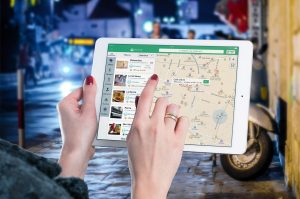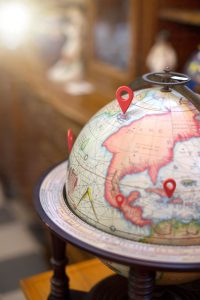Suppliers and experience providers now have access to the first global open map dataset providing groundbreaking business opportunities
The benefits of digital mapping for experience suppliers are enormous. Maps have always been an integral part of the travel industry for both tourism-related businesses and tourists themselves. Accordingly, the advantages range from higher customer satisfaction and repeat business to improved city planning capabilities and efficient work practices. But innovative advancements in digital mapping from Overture Maps Foundation are shaking things up. They’ve unveiled the first global map data set that’s always open.
Early Digital Mapping
Since its inception by the USGS in the 1960s, digital mapping has come a long way for tourism suppliers. Throughout the decades since, technology and satellite advancements, along with the birth of the internet, helped grow digital mapping into what it is today.
Why Maps are Important for Suppliers
Digital mapping provides suppliers valuable insight into customers’ search trends and behaviors to help make more informed business decisions. Companies can optimize their supply chain management and logistics by providing real-time data on traffic patterns, weather conditions and other concurrent information. For example, those using delivery services or suppliers needing up-to-the-minute traffic information can reduce transit times and boost customer satisfaction while standing by their guarantees.
Overture Maps Foundation Innovates Digital Mapping
The collaboration of tech company heavy hitters created a cure for map makers’ urgent need for accurate, accessible and up-to-date geospatial data (time-based information related to specific locations on Earth by combining coordinates, characteristics of objects and life spans of attributes).
To do this efficiently and responsibly, the nonprofit giant Linux Foundation seized an opportunity to work with other tech companies in an effort to pioneer digital mapping. It would be near impossible for a single entity, even an enormous player like Linux, to take on all the intricacies of collecting and maintaining global map information.
In December 2022, OMF started by creating millions of examples of buildings footprints, roads and geographic locations. With the help of Meta, Microsoft, Amazon Web Services (AWS), TomTom and other vital companies, the first alpha release for its geodata (computerized geographical data), named Overture 2023-07-26-alpha.0, was unveiled to the public on July 26, 2023.

Consumers Need Digital Maps
Travelers utilize maps when searching for things like accommodations, local activities, restaurants and cultural adventures. Searches for countless travel-related inquiries are typed into search bars daily. No matter what people are looking for, digital maps can give a clearer picture of your business and its surroundings. This enables users to plan accordingly and are more likely to search areas that have updated digital map information.
How is OMF Different?
OMF provides a unique ability and is different from current applications in its free layers, coupled with being easily conformant with other programs. Simply put, Overture Maps’ data layers are free to use and always open thanks to their application programming interface (API). To put this into perspective, Google’s and Apple’s API charges users to access their information. Currently, Overture Maps combines various sources of open map records to create four geodata layers: Points of Interest (POIs), Administrative Boundaries, Transportation and Buildings. The information is formatted using a recently launched data schema which will aid in standardizing geodata entry. The schema outlines in two parts how the open map data will be structured.
Consistency
Overture Maps allows users and map developers to utilize information in a documented way. In addition, it’s also invaluably interoperable with other systems. According to Marc Prioleau, Executive Director of OMF, “The ongoing challenge lies in maintaining the data amidst constant changes to meet user expectations.”
Simplicity
So, how does OMF do this? By making it easy to add information to create personalized maps. Additionally, it eliminates the need for digital mappers to start layers from scratch by providing four essential underlayers to build from.
The Overture Global Entity Reference System (GERS) also helps by providing a stable ID system that allows users to quickly join additional data types to the map database. By streamlining the process, suppliers can add personalized business information and build onto the program’s infrastructure to fit their needs.

Photo courtesy of Freepik.
What OMF Can Do for Experience Suppliers
With Overture Maps, map data is accessible, consistently updated, extensible, and, most importantly, always open. Suppliers that use online reservation systems, tour services providing activities maps, experience providers, websites with interactive maps and many other tourism industry businesses can benefit from collaborating with OMF.
Because the extensive amount of information is pooled from global members who combine their resources, the result is accurate and consistent mapping information. Companies can contribute their content to the schema, thus adding to Overture Maps’ real-time precise data and optimal digital mapping capabilities.
Be included as a POI in Overture Maps
Suppliers looking to be a part of the innovative mapping system can go to the OMF website and become a member of the Linux Foundation. Once a member, ascertain the geographic information system (GIS) that offers an immense amount of global geodata and start creating.
The Future of Digital Mapping
There must be more alternatives to how geodata is obtained. More importantly, additional globally sourced, reliable and accurate information needs to be open and available to suppliers worldwide. This ensures they can maintain exceptional customer service and comes from OMF’s member contributions coupled with their free API. Overture’s release is a significant step towards this initiative to establish a comprehensive quality open map dataset that is easy to use and profitable for experience suppliers.
Over time, with the help of the mapping community and others, OMF plans to expand the technology. This includes 3D infrastructure data, navigation and routing information, and the number of locations it features. Help is here for businesses in tourism worldwide who need precise location information that is accurate, dependable and expedited.
By Heather Dale



